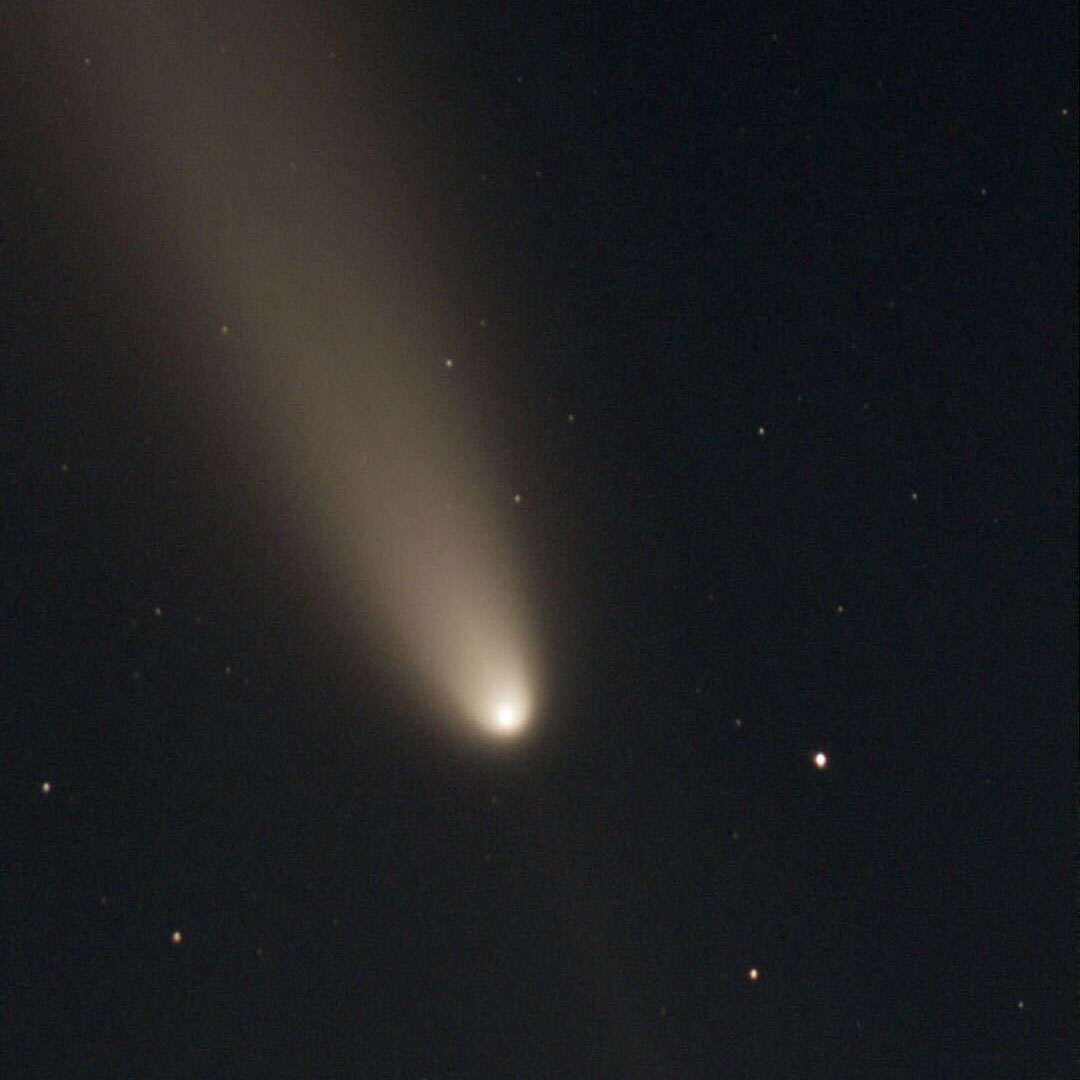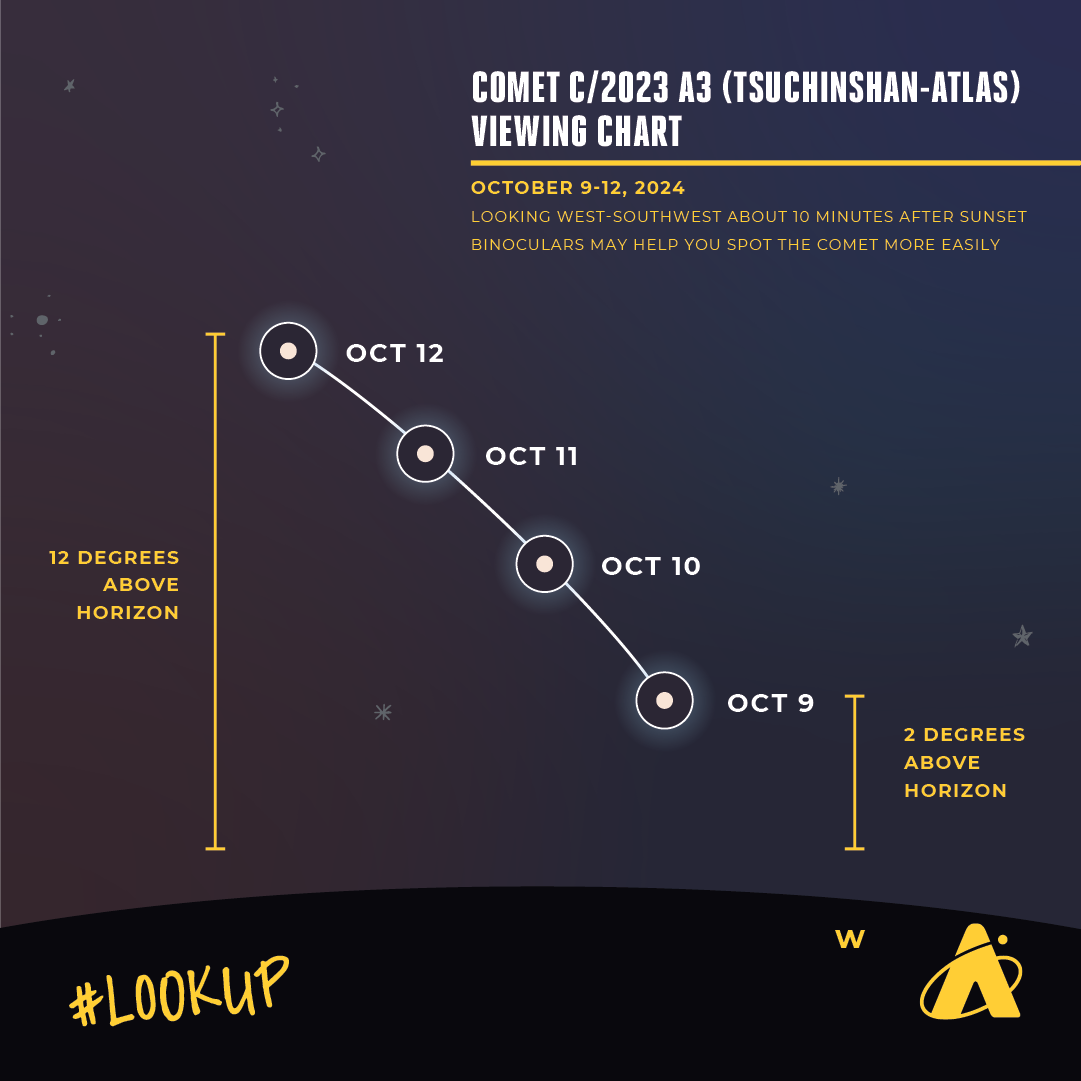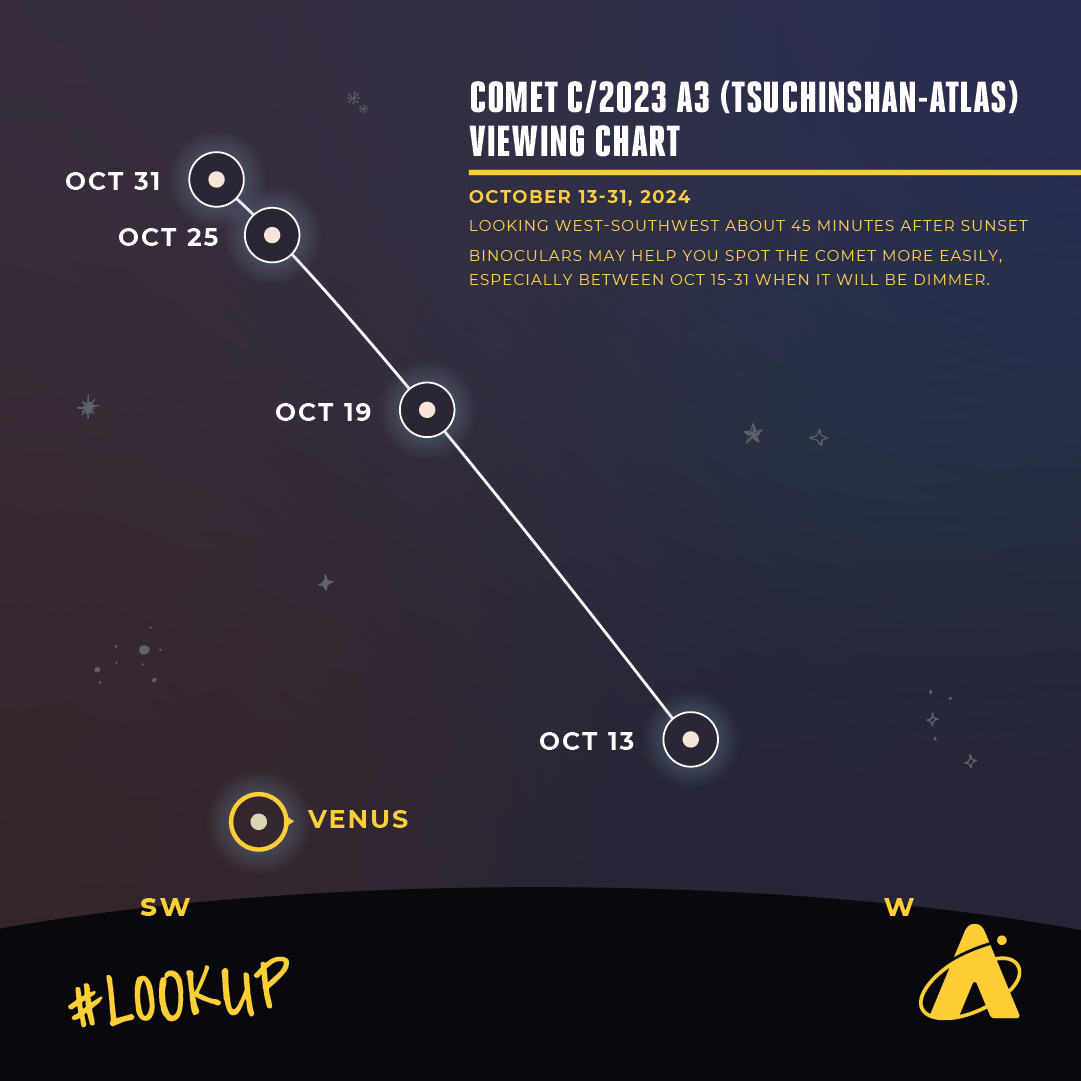Everything You Need To Know About Comet Tsuchinshan-ATLAS AKA Comet C/2023 A3

Header Image: Michelle Nichols and Hunter Miller, Comet C/2023 A3 taken in October 2024
Long ago, comets were, to some, seen as omens of future doom. It seems fitting, then, that we get a potentially bright comet during October 2024 to celebrate the spookiest month on our calendar. Here’s an introduction to Comet C/2023 A3—the latest bright comet to grace our skies in the inner solar system.
Considered a long-period comet, Comet C/2023 A3—also known as Comet Tsuchinshan-ATLAS or Comet Purple Mountain-ATLAS—recently made its closest approach to the Sun, after having traveled from the Oort Cloud. It’s forecasted to be brightest on October 9 around magnitude -3, and around magnitude +2 on October 12 when the comet is at its closest point to Earth.

What Is A Comet?
Comets are leftovers from the formation of our solar system, originating in distant reaches far enough from the Sun where it was cold enough for ices to exist. The word “comet” comes from the Latin word “coma,” which means “hair,” because these objects looked very fuzzy and hairy in the sky.
As comets get closer to the Sun, the Sun’s light and heat causes ices in a comet’s nucleus to turn directly from a solid to a gas, creating a coma. As this temporary cloud of material is blown away from the nucleus by the Sun’s light and by the solar wind, multiple comet tails and trails can form.
For a more in depth overview of comets, please read here!
Where Did C/2023 A3 Come From?
Comets get the designation long-period if their orbits are more than 200 years long; C/2023 A3’s orbit is at least 80,000 years long. It most likely came from a region called the Oort Cloud, which is a spherical volume surrounding the planets that may have formed early on in our solar system’s history when icy objects were flung outward away from the Sun due to the gravitational action of the planets. The Oort Cloud has only been theoretically predicted—we’ve never seen Oort Cloud objects out at their vast distances due to their tiny sizes, cold temperatures, and dark color.
The length of its orbital period, how fast it is traveling, and the angle of its orbit all point to C/2023 A3 being an Oort Cloud comet. At some point in the more recent past, something gravitationally jostled C/2023 A3 (such as the gravitational tug of a passing star) causing it to exit the Oort Cloud, and it started to make its way toward the inner region of our solar system!
So, will this comet be visible from Earth again in 80,000 years? Not necessarily. It depends on how fast the comet speeds away from us after encountering the planets and the Sun. If the comet’s speed is not fast enough to escape the Sun’s gravity, it could theoretically visit us again in the distant future. However, if it is given enough of a kick in speed by the gravity of other objects, its orbit could become hyperbolic. This means that it might eventually escape the gravitational pull of the Sun. For comets in extremely elliptical orbits, it doesn’t take much of an influence to have their orbits perturbed by gravity to either slow them down or speed them up. A comet’s first visit here might be its last!
How Bright Will The Comet Get?
That, unfortunately, is one of the hardest questions to answer about comets. No two comets are exactly the same, and we don’t know for sure what a comet is going to do until the Sun’s light and heat interact with it.
One thing to note about comet brightness is that the comet will not be uniformly bright all along its entire length. The end of the tail will usually be fainter than the head, so therefore the head of the comet will likely be the part of the comet that is easiest to see. The full extent of the comet’s tail will probably show up better in photographs.
October 9, 2024–October 12, 2024

One potentially very interesting date for this comet is October 9, 2024. Right at the time of sunset, the comet will be very, very low to the horizon—only a few degrees up. The low angle between the comet and the Sun means that sunlight scattered by dust from the comet might temporarily bump up the comet’s brightness significantly, possibly to around magnitude -2.5, which is about as bright as Jupiter is in our night sky. However, because the comet will be extremely low to the horizon, looking through that much air plus being in so much sunset glare might counteract much of that visual brightness bump. It will also only be above the horizon for about 15 minutes or so after sunset before it sets.
Experienced skywatchers who know exactly where to look may be able to see the comet in the daytime before the Sun sets, but do not attempt this unless you know exactly what you are doing due to the real possibility of permanent eye damage from accidentally viewing the Sun directly.
If you point an unfiltered telescope or pair of binoculars at the Sun, eye damage from the burn will be instantaneous and eyesight loss will be permanent. In other words—just wait until the Sun fully sets to try to find the comet on October 9. Or, better yet, wait another day or two for the comet to be higher in the sky after sunset. It won’t be as bright as it might be on October 9, but at least you won’t risk your vision as much trying to find it. The comet could be nearly as bright just after sunset on October 10, 2024–October 11, 2024.
October 13, 2024–October 31, 2024

On October 12, 2024–October 13, 2024, the comet will be around magnitude +2, possibly around magnitude +1. Magnitude +2 is about as bright as Polaris in our night sky. It will begin to dim after that date. The Moon’s light may interfere a bit with the brightness of the comet around mid-October, as well. By the end of October 2024, the comet will be a lot dimmer, probably around magnitude +6, which is at the human limit of naked-eye visibility under a very dark sky. Viewers in light polluted locations will need binoculars or a small telescope to see it then.
How Was This Comet Named?
Each part of a comet’s name has a purpose! It helps us identify what kind of comet it is, when it was discovered, and where it was discovered.
Comet C/2023 A3 (Tsuchinshan-ATLAS)’s name can be broken down like this:
- C/ means that this comet is classified as a non-periodic comet, which is the designation for comets that don’t have a regular orbit around the Sun or comets whose orbits are more than 200 years long
- 2023 identifies the year this comet was discovered
- A3 tells us the time period of the year that this comet was discovered with an alphabetic letter and a number to signify how many other comets were discovered in this time period
- A = the first half of January, B = the second half of January, and so on and so forth, except the letter I and Z are never used
- Tsuchinshan-ATLAS = the names of the two observatories that jointly get credit for discovering the comet. Pronunciation: [zz-jing-shan]-ATLAS. Transliteration: Purple Mountain [Observatory]-ATLAS.
Tips and Tricks For Seeing This Comet
- Check the weather beforehand
- Double check that you live or are observing from a latitude that is not too far south to see the comet in the early evening
- Look for a fuzzy object, possibly with a short wispy tail pointing away from the Sun
- When the comet will be closest to Earth, there will be a bright Moon in the sky at the same time that might make naked-eye viewing of the comet a little harder
- Binoculars might help you locate it, especially after October 15, but do not start using binoculars to find it until the Sun has fully set below the horizon. You will cause permanent damage to your eyes from accidentally viewing the Sun directly. If you point an unfiltered telescope or pair of binoculars at the Sun, eye damage from the burn will be instantaneous and eyesight loss will be permanent.
Learn From Our Astronomy Educators
Watch our Sky Observers Hangout livestream on October 15, 2024 starting at 6:00 pm CT to learn what makes these icy bodies tick and how you can catch a view of this comet before it is propelled back out to the far reaches of the solar system—possibly never to be seen again. Weather permitting, our astronomy educators Michelle and Hunter may show a live view of Comet C/2023 A3 as it sets over Chicago’s skyline. Subscribe to the Adler’s YouTube channel to get notifications about upcoming livestreams and new content so you don’t miss an episode!







